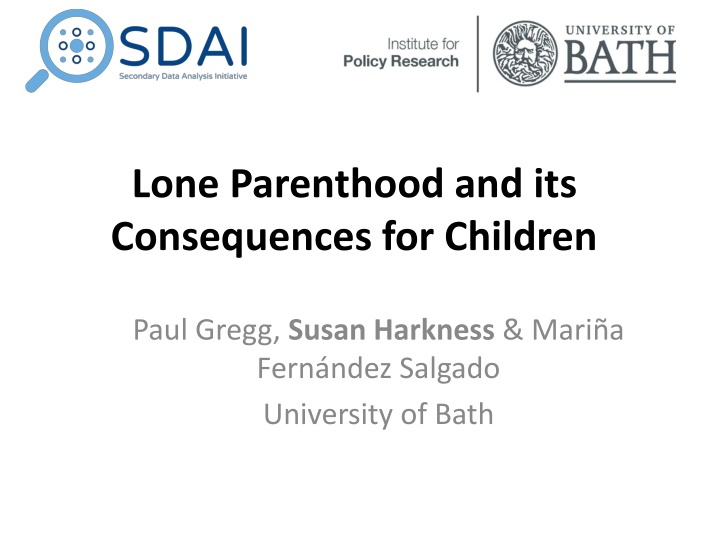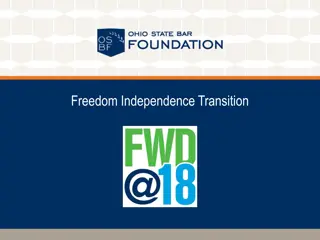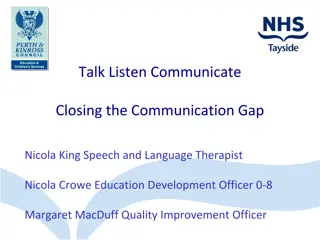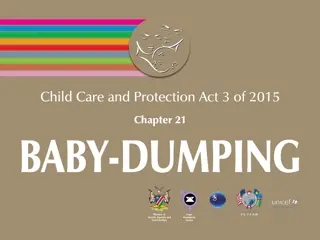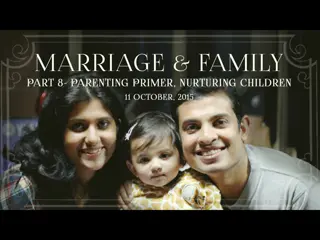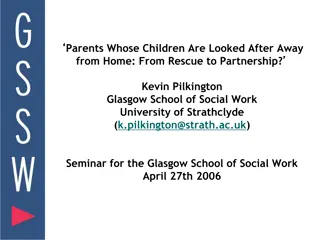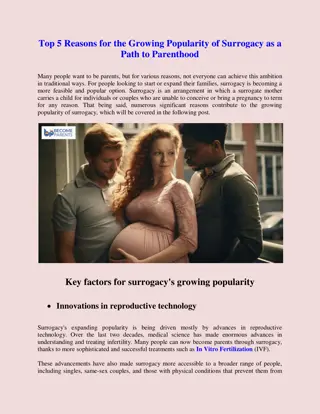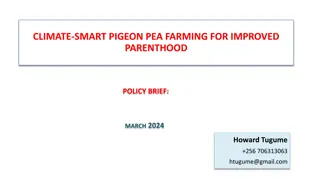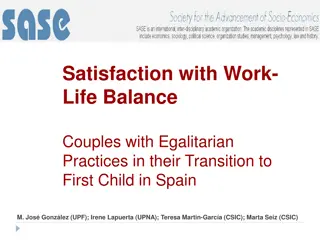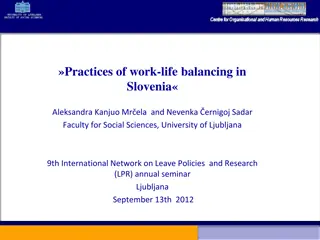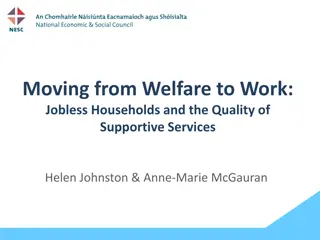Lone Parenthood and Children's Development
Examining the impact of lone parenthood on children's cognitive and emotional development, this research delves into changes in family structures and consequences for children brought up by lone mothers, using data from various UK birth cohorts. The study aims to provide updated insights on the prevalence and outcomes of lone motherhood in contemporary society.
Download Presentation

Please find below an Image/Link to download the presentation.
The content on the website is provided AS IS for your information and personal use only. It may not be sold, licensed, or shared on other websites without obtaining consent from the author.If you encounter any issues during the download, it is possible that the publisher has removed the file from their server.
You are allowed to download the files provided on this website for personal or commercial use, subject to the condition that they are used lawfully. All files are the property of their respective owners.
The content on the website is provided AS IS for your information and personal use only. It may not be sold, licensed, or shared on other websites without obtaining consent from the author.
E N D
Presentation Transcript
Lone Parenthood and its Consequences for Children Paul Gregg, Susan Harkness & Mari a Fern ndez Salgado University of Bath
Motivation Children that have experienced some time growing-up in a lone-parent family are widely considered to do less well than children from families that are intact. they have relatively poor cognitive / educational outcomes; exhibit more behavioural and emotional problems; and are more likely to engage in risky behaviour as young adults. But most UK evidence: uses data on cohorts of children born 30-years of more ago, and is based on the experience of children who were growing up at a time when lone parenthood was relatively rare.
Aims We aim to update the UK evidence base looking at changes in: the experience of children growing up in lone-mother families, and its consequences for their cognitive and emotional development.
Research questions (1) How has the experience of lone motherhood changed? How common is the experience of lone motherhood? How have routes into lone motherhood changed? How selected are lone mothers?
Research questions (2) What are the consequences of having being brought up with a lone mother? What influence does having lived with a lone mother have on (i) cognitive, and (ii) emotional development at early and middle childhood? Does the timing of lone motherhood matter to these outcomes? What factors drive these relationships? Is lone motherhood a cause of poor performance? or, is it a result of selection into lone motherhood? or, a result of other changes in circumstances which are a consequences of lone parenthood (such as loss of income or poor maternal mental health)? How diverse are the effects of lone motherhood on children s outcomes?
Data: Birth Cohorts National Child Development Study (NCDS) - 1958 Cohort. - Ages of 7, 11, 16. British Cohort Study (BCS)- 1970 Cohort. - Ages 5, 10, 16. Millennium Cohort Study (MCS)- 2000 Cohort. - 9 months, age 3, 5, 7 and 11 (education data still to be released!)
How Common is Lone Motherhood? Changes in Family Structure
Changes in Family Structure by Age Family Structure: 1958 Cohort Family Structure: 2000 Cohort 35% 35% 30% 30% 25% 25% 20% 20% 15% 15% 10% 10% 5% 5% 0% 0% 0 7 11 16 0 7 11 16 Lone Mother Mother and step-father Other Lone Mother Mother and step-father Other
Changes in Family Structure by Age Family Structure: 1970 Cohort Family Structure: 2000 Cohort 35% 35% 30% 30% 25% 25% 20% 20% 15% 15% 10% 10% 5% 5% 0% 0% 0 5 10 16 0 5 11 16 Lone Mother Mother and step-father Other Lone Mother Mother and step-father Other
How common is lone motherhood? There has been a sharp decline in the number of children living with both natural parents, with large increases in: those born to lone mothers, and parental separation (a large number of separations taking place at an early age). The falling number of children living with both natural parents is increasingly associated with a rise in lone parenthood: In 1958 those children born to lone mothers, or whose parents separated, were frequently brought up by non-natural parents. Between 1958 and 1970 the share of children living with both natural parents declined but there was no growth in lone parenthood. Instead there was a sharp rise in step-parent families. By 2000 lone parenthood was much more common , both because fewer children were living with both natural parents and because mothers that separated were much less likely to have repartner.
How Selected are Lone Mothers?
Childrens Experience of Lone Motherhood by Child Age and Mother s Education 1958 and 2000 1970 and 2000 Basic 1958 Basic 2000 Basic 1970 Basic 2000 Post-16 1958 Post-18 2000 Post-18 1970 Post-18 2000 50% 50% 40% 40% 30% 30% 20% 20% 10% 10% 0% 0% AT BIRTH BY 7 BY 11 BY 16 AT BIRTH BY 5 BY 10 BY 16
Childrens Experience of Lone Motherhood by Child Age and Mother s Age at Birth 1958 and 2000 1970 and 2000 Under 21 1958 Under 21 2000 Under 21 1970 Under 21 2000 30 plus 1958 30 plus 2000 30 plus 1970 30 plus 2000 70% 70% 60% 60% 50% 50% 40% 40% 30% 30% 20% 20% 10% 10% 0% 0% AT BIRTH BY 7 BY 11 BY 16 AT BIRTH BY 5 BY 10 BY 16
How do children who have lived with lone mother families fair? Cognitive and Behavioural Outcomes
Deficits in Children's Cognitive Scores: Lone Mother, Age 5 and 10/11 1970 Cohort 2000 Cohort 0 0 LM at birth LM during early childhood LM during middle childhood LM during late childhood LM at birth LM during early childhood LM during middle childhood LM during late childhood -0.1 -0.1 -0.2 -0.2 -0.3 -0.3 -0.4 -0.4 -0.5 -0.5
Deficits in Children's Cognitive Scores: Lone Mother, Age 7 and 11 1958 Cohort 2000 Cohort 0 0 LM at birth LM during early childhood LM during middle childhood LM during late childhood LM at birth LM during early childhood LM during middle childhood LM during late childhood -0.1 -0.1 -0.2 -0.2 -0.3 -0.3 -0.4 -0.4 -0.5 -0.5
Children experiencing lone motherhood have poorer cognitive outcomes than average, and There has been little change in the size of cognitive gaps over time. Negative effects are much larger for those experiencing lone motherhood early on. Gaps in attainment are similar for children at different ages, and For those that separate later (in mid-childhood), gaps in attainment are observed prior to the parental split.
Emotional Gaps Age 5 (1958 & 2000) Age 7 (1970 & 2000) 0.1 0.1 0 0 LM at birth LM during early childhood LM during middle childhood LM during late childhood LM at birth LM during early childhood LM during middle childhood LM during late childhood -0.1 -0.1 -0.2 -0.2 -0.3 -0.3 -0.4 -0.4 -0.5 -0.5 -0.6 -0.6
But, does lone motherhood cause poor performance?
Modelling the effect of LP on outcomes.. We look separately at the effect of lone mother hood on children s outcomes for those that are .. Lone Mothers at Birth Become Lone Mother between Birth and Early Childhood Become Lone Mother between Early and Late Childhood
Modelling the effect of LP on outcomes.. Models: Model 1: Family Structure only (raw effect). Model 2: + Child and Mother Characteristics. child gender, low birth weight, ethnicity, mother s age and education Model 3: + Father Characteristics Model 4: + Mediating factors employment, income, and mental health Model 5: + Past Attainment
Effect of Characteristics on Cognitive Outcomes Lone Mother at Birth and Early Childhood Age 5: 1970 & 2000 Age 7: 1958 & 2000 0.2 0.2 0.1 0.1 0 0 Income Income Employment Employment Employment Employment Raw gap Raw gap Raw gap Raw gap Mother controls Father Controls Mother controls Father Controls Mother controls Father Controls Mother controls Father Controls -0.1 -0.1 -0.2 -0.2 1970 2000 1958 2000 -0.3 -0.3 -0.4 -0.4 -0.5 -0.5 Lone Mother at Birth Lone Mother at Early childhood Lone Mother at Birth Lone Mother at Early childhood
Does lone motherhood leads to poor cognitive outcomes? Cognitive gaps during early childhood have remained relatively constant over time, and A large part of the gap can be explained by mother characteristics, such as age and education. This is particularly the case for those who were born to a lone mother. For those who s parents separate during early childhood, fathers characteristics add further explanatory power. But factors that are related to living with a lone mother matter too Controlling for income and employment eliminates the gap .
Effect of Characteristics on Emotional Outcomes: Lone Mother at Birth and Early Childhood Age 5: 1970 & 2000 Age 7: 1958 & 2000 Effect of characteristics on age 5 Emotional Outcomes Effect of characteristics on age 7 Emotional Outcomes 0 0 Income Income Raw gap Raw gap Raw gap Raw gap Employment Employment Employment Employment Mother controls Mother controls Mother controls Mother controls -0.1 -0.1 -0.2 -0.2 1970 Cohort 2000 Cohort 1958 Cohort 2000 Cohort -0.3 -0.3 -0.4 -0.4 -0.5 -0.5 -0.6 -0.6 Lone Mother at Birth Lone Mother at Early childhood Lone Mother at Birth Lone Mother at Early childhood
Does lone motherhood leads to poor emotional outcomes? But the gap in emotional development of those in lone mother families and intact families is widening. Mother s characteristics explain a smaller part of the gap (particularly for those who enter lone motherhood after birth), but employment and income matter particularly for those born to lone mothers. After controlling for characteristics, it is those who become lone mothers later that have the worst outcomes.
Other (preliminary) findings Re-partnering: Re-partnering is associated with worse child outcomes compared to otherwise equivalent intact of lone mother families. There is heterogeneity in the effect of lone motherhood on children s outcomes: there are larger negative effects for those with more educated or older mothers, and across the ability distribution, the largest negative effects are seen for the most able (who underperform relative to their high ability peers in intact families, after controlling for other characteristics).
Position in the Cognitive Ability Distribution, 2000 Age 5 Age 7 Age 5 Age 7 18% 18% 16% 16% 14% 14% 12% 12% 10% 10% 1 2 3 4 5 6 7 8 9 10 1 2 3 4 5 6 7 8 9 10 8% 8% 6% 6% 4% 4% 2% 2%
Key Messages (1) Lone parenthood is common up to half of all children will spend some time with a lone mother. It has grown partly because fewer children are being brought up in other family forms (by grandparents, adopted etc), and entry into lone motherhood has changed there is more lone parenthood at birth, but there has also been a growth in separation, particularly during early childhood Family structures are increasingly diverging by mothers education and age: those whose mothers left school at or before 16 are three times more likely to be born to a lone mother, and twice as likely to experience lone motherhood by the age of 11, and Two-thirds of those whose mother was under 21 at birth had experienced lone parenthood by age 11.
Key Messages (2) But, the consequences of lone parenthood for children s cognitive development are diminishing. Lone parenthood today has little effect on children s development once other characteristics are accounted for. But preliminary evidence suggest that gaps remain in emotional development for those in lone mother families which are not fully explained by characteristics. And the effect of lone parenthood is not heterogeneous if anything it appears to be more detrimental for children of better educated and older mothers, and for high ability children.
Cognitive Outcomes We use a single measure of cognitive skills (Carneiro et al. 2007): NCDS-1958 cohort: Age 7: maths, reading, copying and drawing. Age 11: maths, reading, copying and general ability (verbal and non-verbal). BCS-1970 cohort: Age 5: test on vocabulary, copying designs, human figure drawing and profile recognition. Age 10: British Ability Scale (BAS). It includes measures of word definition, recall of digits, similarities and matrices. MCS-2000 cohort: BAS at Age 5: Naming vocabulary, picture similarity, pattern construction BAS at Age 7: Pattern Construction, Word Reading, Number Skills MCS and BCS measures are age adjusted standardized scores.
Emotional Outcomes Data from the Strengths & Difficulties Questionnaire. Single item score with a normalised distribution. 5 Categories each with 5 items relating to Emotional symptoms Conduct problems Hyperactivity/inattention Peer relationship problems Prosocial behaviour
